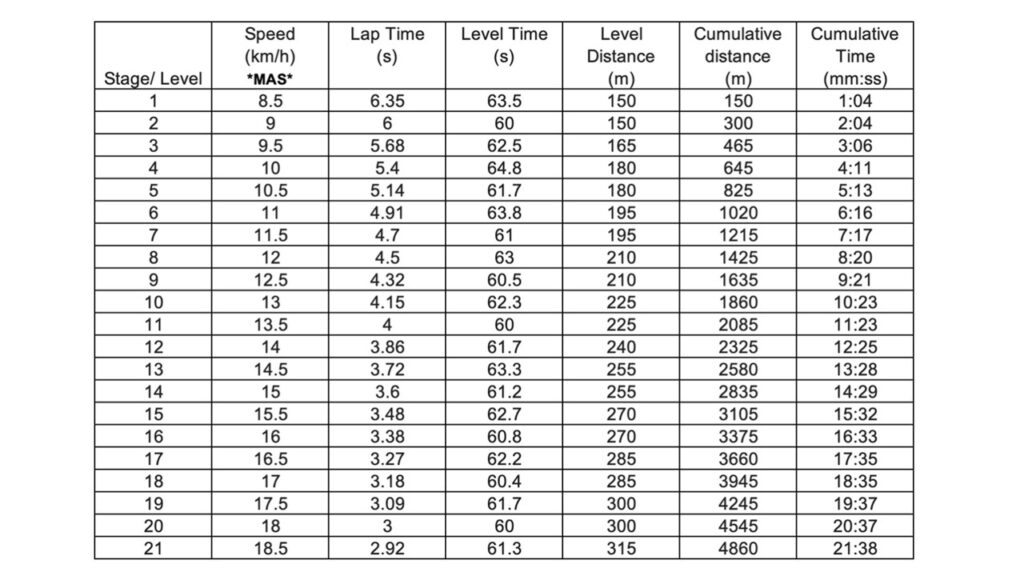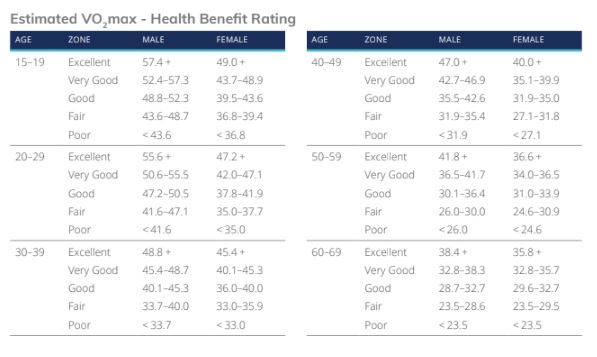Chapter 13 – Fitness and Stress Assessments
Cardiorespiratory Fitness Assessment
Martin Dubuc
As was discussed in Chapter 4: Cardiorespiratory Fitness, Cardiorespiratory Assessments aim to assess an individual’s capacity to accomplish two fundamental physiological processes:
- Take in oxygen through the respiratory system and deliver it to the working tissues via the cardiovascular system (and conversely, remove metabolic waste and carbon dioxide from the working tissues and remove them from the body via metabolic processes and the respiratory system).
- Use the delivered oxygen to produce Adenosine triphosphate (ATP), our body’s energy currency, to power muscular contractions.
The greater their ability to accomplish the aforementioned processes, the greater an individual’s Maximal Oxygen Consumption – VO2 max will be (i.e., the rate of oxygen uptake/consumption during maximal aerobic exercise). This directly translates to the body’s ability to maintain higher intensities of aerobic exercise for extended periods of time. VO2 max is measured in ml/kg/min – in other words, how many millilitres of oxygen are consumed per kilogram of body weight per minute while exercising at the maximal aerobic intensity.
When assessing cardiorespiratory endurance, tests can be Direct (directly measuring the oxygen consumed by the body using masks and gas analysis software) or Indirect (using various variables such as workload, heart rate, distance, time, stage completion, etc. to predict what the oxygen consumption is). This course will specifically make use of Indirect protocols to allow you to estimate your VO2 max. In this chapter, you will find various tests that may be employed during your time as a PARA student to assess your current level of cardiorespiratory endurance.
Activity 1.1: 1.5 mile/ 2.4km Cooper Run
This test operates on the premise that the distance a subject can run in a specified time is determined by their ability to maintain a high level of oxygen consumption. The principle is simple: fitter individuals will be able to run the 2.4km distance in less time. Conversely, the 12-minute Cooper test works on the same premise, but subjects run the furthest distance possible in this case in 12 minutes.
Procedure:
This test should be conducted on a flat surface without risks of interruptions (traffic lights, etc.), which is why a 400m track is recommended (6 laps total – 6 x 400m = 2400m. The objective is to cover the 2.4km distance as quickly as possible while maintaining the fastest steady exercise pace possible. In other words, do not start too quickly or else you may be forced to slow down/walk later, but do not start too slowly where you end up running much faster in later laps. It is worth noting that participants tend to improve their performance on this test when re-testing, not due to training, but due to learning how to pace themselves from their previous trial. For this reason, a practice test is often recommended a few days before the official test. A warm-up lap is also recommended, which includes light jogging, dynamic stretching, or other exercises to help increase your heart rate and warm up your muscles.
Once you are ready, record how much time it takes you to travel the 2.4km distance in minutes and seconds. If your timing device provides lap times, use this feature to help you maintain a steady pace. Once you have completed the run, walk a lap / for 5 minutes at a slow pace to allow the body to cool down and recover.
VO2max calculation:
- Take your recorded time (in minutes and seconds) and convert it to minutes by dividing the number of seconds by 60. For example, if a student runs the 2.4km in 12 minutes and 15 seconds, their exercise time is converted to 12 minutes and (15 / 60 = 0.25) – 12.25 minutes.
- Using your exercise time in minutes calculated in Step 1 above, insert it in the formula below (It is worth noting that there are many variations of the formula below that can be used to estimate VO2max from a 2.4km run, including some that take biological gender and heart rate into consideration):
(483 / time in minutes) + 3.5
Continuing with the example above, a student who completes the test in 12.25 minutes would be calculated as:
VO2max = (483/12.25) + 3.5 → 39.43 + 3.5 = 42.93 ml/kg/min
3. Once you have calculated your VO2max, you can refer to the reference table at the end of this chapter to find your Cardiorespiratory Endurance rating.
Activity 1.2: 20m Shuttle Run
This test is a requirement for the PARA students’ fitness testing and is described in detail in the PARA Fitness Test Descriptions chapter of this textbook (including the stages and equivalent grades). As such, it will only be briefly covered here, particularly expanding on how the 20m Shuttle Run can also be used to estimate VO2max.
The 20m Shuttle Run, often referred to as the “Beep Test”, the PACER test, or the Leger Shuttle Run, estimates a subject’s VO2max by having them run a 20-meter distance back and forth at increasingly faster speeds with each stage (determined by audio cues, or “beeps” provided by an audio track). The premise is that a steady pace running speed would provide a similar VO2 score for different individuals. Those with higher cardiorespiratory endurance (or oxygen consumption capacity) will be able to maintain the required cadence into the later and faster stages of the test, while less fit subjects will be forced to quit the test sooner as they cannot keep the pace.
VO2max calculation:
Using the table below, determine your maximal attained running speed (MAS) based on the stage you were at when the test was terminated. Use the fastest speed you were running at, even if you did not successfully complete that stage. E.g., if a student quits the test after two shuttles into stage 7, their MAS would be 11.5 km/h.

Once you have determined your MAS, insert it in the formula below (It is worth noting that there are many variations of the formula below that can be used to estimate VO2max from a 20m Shuttle Run Test based on your source, which may vary your final VO2max score by a few points):
VO2max = -24.4 + (6 x MAS)
Continuing with the example above, a student who reaches stage 7.5 would be calculated as:
VO2max = -24.4 + (6 x 11.5km/h) → -24.4 + 69 = 44.6 ml/kg/min
VO2 Max Ratings
Just as some of the formulas seen above may vary slightly based on the publication source, the ratings associated with VO2max scores can also vary depending on which reference you are using. The following rating table is established by the Canadian Society of Exercise Physiology (CSEP), which is considered the Gold Standard of Personal Training and Fitness Assessment in Canada.

Taken from CSEP Physical Activity Training for Health® (CSEP-PATH®) Resource Manual, 3rd Edition
Reflection Questions
A. Based on the completion of either the 1.5 mile/2.4km Cooper Run OR the 20m Shuttle Run, answer the following:
-
- What is your VO2max and associated Rating? Show your times/stage and calculations.
- Is this result what you were expecting? Justify your answer.
- Are you satisfied with your VO2max and Rating? Based on your response, how do you plan on improving or maintaining your current result?
B. If you have completed BOTH the 1.5 mile/2.4km Cooper Run AND the 20m Shuttle Run this semester, answer the following:
- What is your VO2max and associated Rating for each test? Show your times/stage and calculations. Is this result what you were expecting? Justify your answer.
- In your opinion, which test is more challenging to complete and why? Is this the test that gave you a lower or a higher score?
- Which of these two tests do you believe to be more representative of your current state of cardiorespiratory endurance? Explain why.

